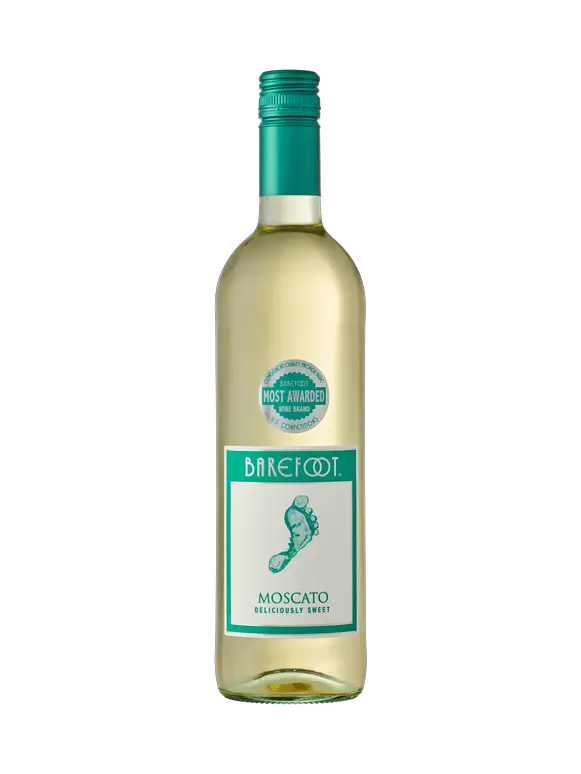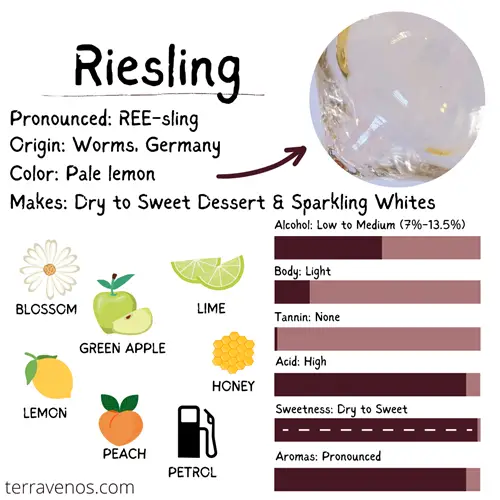| Characteristics | Moscato | Riesling |
|---|---|---|
| Hue | Pale lemon | Pale lemon |
| Color | White | White |
| Aromas | Musky, orange blossom, tropical fruit | Floral, citrus, stone fruit |
| Sweetness | Mostly sweet | Range from dry to very sweet |
| Acid | Moderate to high | High |
| Alcohol (%) | 5-11% | 8-13% |
| Body | Light | Light to medium |
| Intensity | Moderate | Moderate to pronounced |
| Bubbles | Slightly effervescent | None |
| Grape | Moscato Bianco | Riesling |
| Key Growing Regions | Italy, California, Australia | Germany, Alsace, Austria |
| Classic Pairings | Desserts, fruits, light cheeses | Spicy cuisine, Asian dishes |
| Price Range | $5-$20 | $10-$40+ |
Moscato vs Riesling is a natural comparison; two white wines that can come in sweet styles.
Moscato is always sweet, lighter, lower in acid, and bubbly, with tropical fruits and floral notes. Riesling can be dry or sweet, isn’t bubbly, and has higher acid, and citrus flavors. Both wines are widely available. Moscato is generally less expensive than Riesling.
Here’s what you need to know about Moscato vs Riesling and a quick video to get you started if you just want the basics:

- What Is Moscato Wine?
- Riesling Basics: A Versatile German Classic
- Wine Comparison: Moscato vs. Riesling
- Moscato vs. Riesling Winemaking
- Moscato vs. Riesling: Food Pairings and Serving Temperature
- Which Is More Expensive, Moscato vs. Riesling?
- Which Is Better, Moscato vs Riesling?
- Final Thoughts – Riesling vs Moscato?
- Thirsty for More?
What Is Moscato Wine?

If you’re comparing Moscato and Riesling, then you’re probably thinking about the light, sweetish white wine that has a slight effervescence to it. The most famous of this style of wine is Moscato d’Asti DOC, from Italy’s northwestern Piemonte region.
Jargon Alert: DOC stands for Denominazione di Origine Controllata (literally Controlled Designation of Origin), which is a demarcated region where a wine style comes from in Italy. Here are all of the Italian wine classifications explained (just in case you’re curious).
Moscato d’Asti, or just Asti, is made from a cultivar of Moscato grapes (there’s no actual grape called “Muscat”, which is unhelpful. The grape that makes your lovely fizzy Moscato is Moscato Bianco, or Muscat Blanc a Petit Grains, one of the most perfumed and aromatic of the Muscat family.
Helpful Tip: Here’s a rundown of everything you need to know about Muscat and its many versions.
Riesling Basics: A Versatile German Classic

Riesling, a classic German grape, boasts a rich heritage and worldwide fame. Thriving in regions like the Mosel and Rheingau, Riesling displays a unique balance of sweetness, acidity, and minerality. Ranging from bone-dry to lusciously sweet, Riesling caters to various palates, making it a fun wine to explore.
If you are comparing Moscato and Riesling, you’re most likely thinking of an off-dry, lighter style of Riesling called Kabinett or maybe even a Spätlese. These Riesling wines can be dry, but most often they’re made in an approachable, friendly, slightly sweet, non-sparkling style.
Helpful Tip: Go check out this complete guide to Riesling wines.
Today, Riesling has transcended its German roots, with vineyards in regions such as Alsace, France, Finger Lakes in the United States and Australia.
Fun Wine Fact: Riesling is known for its aging potential, with some high-quality Rieslings improving over decades. The grape’s naturally high acid acts as a preservative.
Wine Comparison: Moscato vs. Riesling
Here’s a quick side-by-side that covers the most common styles of Moscato vs Riesling.
Moscato Wine Profile
- Sweetness: Moscato is typically produced in a sweet style, offering noticeable residual sugar.
- Alcohol: Moscato wines generally have a low alcohol content, ranging from around 5%-8% ABV.
- Body: Known for its light body, Moscato provides a refreshing and easy-drinking experience.
- Acid: While still crisp, Moscato tends to have milder acidity compared to Riesling.
- Flavor and Aroma Intensity: Moscato exhibits delicate tropical fruit flavors and floral aromas.
- Flavors: The flavor profile often includes notes of peach, apricot, orange blossom, and sometimes a touch of honey.
Riesling Wine Profile
- Sweetness: Riesling wines vary from dry to sweet, offering a broad range of styles.
- Alcohol: Riesling wines typically have a low to medium alcohol content, ranging from around 8% to 13% ABV.
- Body: Riesling is known for its medium body.
- Acid: Riesling showcases vibrant acidity, more pronounced than Moscato
- Flavor and Aroma Intensity: Riesling boasts citrus notes, mineral undertones, and a complex aromatic profile. You may even smell petrol, or gasoline.
- Flavors: The flavor profile often includes green apple, lime, slate, and sometimes a hint of petrol if aged.
Are Moscato and Riesling Similar?
Moscato and Riesling are similar. They are fruit-forward white wines. Off-dry Kabinett styles of Riesling will taste very similar to Moscato wines. Look for lower-alcohol Rieslings (8% ABV) or bottles that say “Kabinett” on them.
What Is the Difference Between Moscato and Riesling?
Riesling tends to have a medium body, compared to Moscato’s light body. Riesling often exhibits citrus notes, mineral undertones, and a complex aromatic profile, while Moscato leans towards sweet tropical fruit flavors. Riesling has more pronounced acidity, making it taste sharper in your mouth.
Moscato vs. Riesling Winemaking
Both Moscato and Riesling undergo protective winemaking techniques to preserve freshness and emphasize their unique characteristics. Stainless steel and temperature-controlled fermentation are commonly employed.
Winemakers capture CO2 from the fermentation process to give Moscato wines their bubbles. Riesling wines are always still (not bubbly) (unless you have a sparking style, called Sekt).
Winemakers can decide to make Riesling wines in a fully dry, off-dry, or lusciously sweet style. Look at Riesling wine labels to figure out what style you’re holding.
Helpful Wine Buying Tip: Here’s a quick guide on how to figure out if the bottle of wine you’re holding is sweet or dry.
Moscato vs. Riesling: Food Pairings and Serving Temperature
Moscato’s sweet and fruity character makes it a versatile companion for a variety of fruit salads, spicy dishes, and as a refreshing aperitif. Riesling, with its vibrant acidity and complex flavor profile, pairs exceptionally well with a range of foods, including Asian cuisine, seafood, and spicy dishes.
Personal Note: I love drinking both of these wines on their own, no need for food pairing.
Both Moscato and Riesling are best enjoyed chilled. Place them in the refrigerator for a few hours before serving.
Which Is More Expensive, Moscato vs. Riesling?

When comparing the prices of Moscato and Riesling, it’s natural to wonder about their relative costs.
Moscato Cost
Entry-level Moscato wines are typically affordable, ranging from $5-$8 USD per bottle. If wine affordability is something you’re thinking about, Moscato is an accessible choice without compromising on the sweet and fruity flavors that make this wine so popular. If you are looking for premium Moscato, there are higher-priced Moscato wines available. These bottles, priced around $15 to $20 or higher, offer a more complex and nuanced drinking experience.
Riesling Cost
Similar to Moscato, entry-level Riesling wines also fall within accessible price ranges, usually ranging from $10 to $15 per bottle. These wines are known for their versatility, showcasing a broad range of styles suitable for various preferences.
On the premium side, Riesling will have more intense flavors and aging potential. You’ll immediately notice just how pronounced they can be. Premium Riesling wines sourced from renowned regions can have prices ranging from $30 to $50 or more.
Which Is Better, Moscato vs Riesling?
If you enjoy sweet, fruity, slightly bubbly white wine, Moscato will be better for you. If you enjoy higher acid, still white wines with layered complexity, then go for Riesling. If you’re on a budget, Moscato is generally less expensive than Riesling and a great choice.
Final Thoughts – Riesling vs Moscato?
Both Moscato and Riesling present delightful white wine options with their own unique characteristics. I’m a big fan of side-by-side tastings to tease out the different wine characteristics.
A great way to get started with these two wines is to do a side-by-side comparison. Grab 2 bottles of similarly priced Moscato and Riesling. Invite over a few friends and enjoy an afternoon of swirling and sipping.
Moscato showcases a sweet and fruity nature at a price point that makes the wine a great choice for any occasion – or no occasion at all! If you’re looking for a versatile and complex wine, then Riesling will be a fun choice that captivates your palate with vibrant acidity and a diverse flavor profile.
Thirsty for More?
I’m a big believer in side-by-side tastings to enhance your wine knowledge. Here’s how to host your own wine tasting for beginners.
Love Moscato? Here’s a list of other sweet white wines that you’ll probably enjoy, too.
You should be able to find delightful wines at every price point. Explore this post on how to discover hidden gems under $50.




